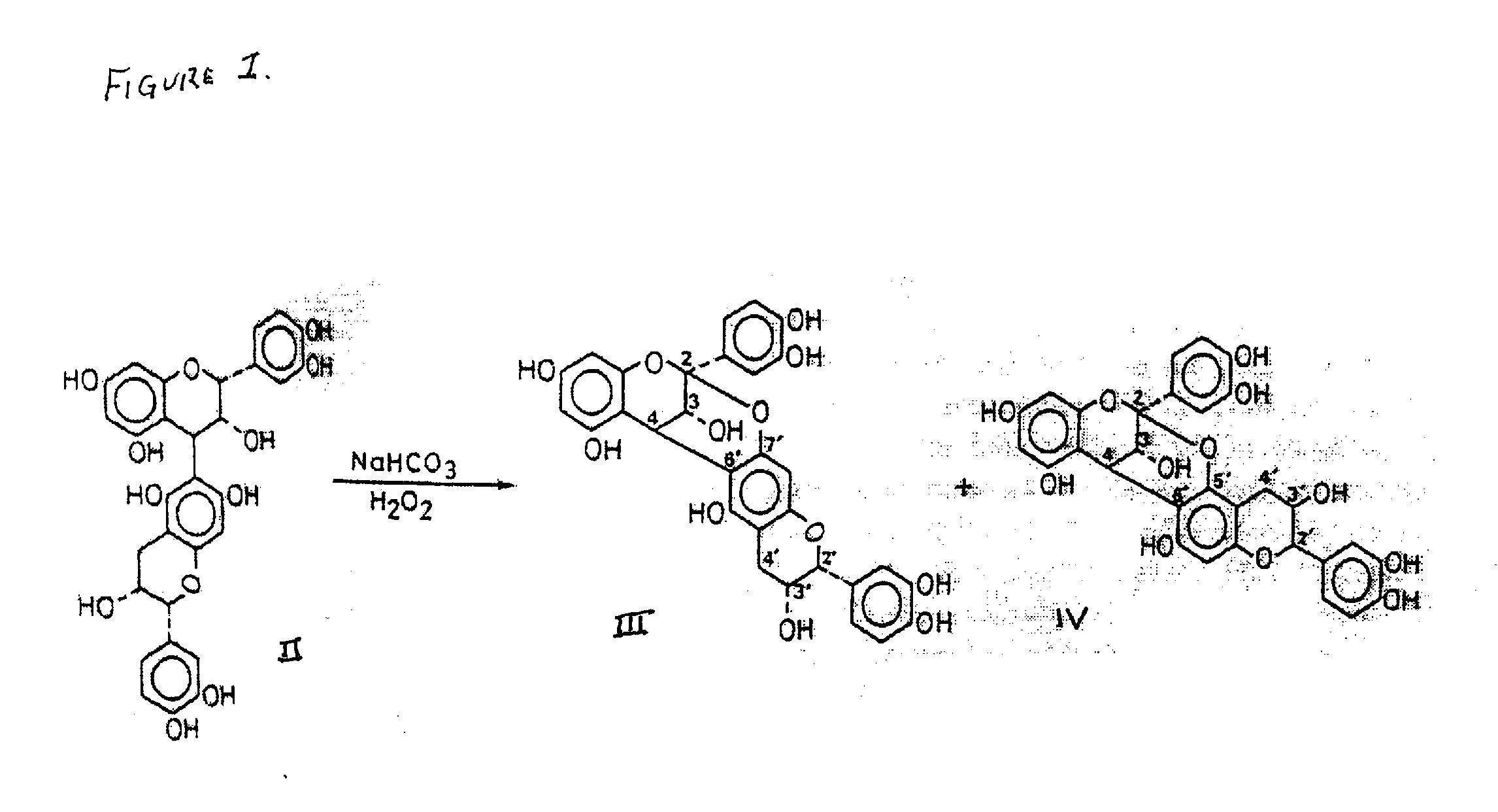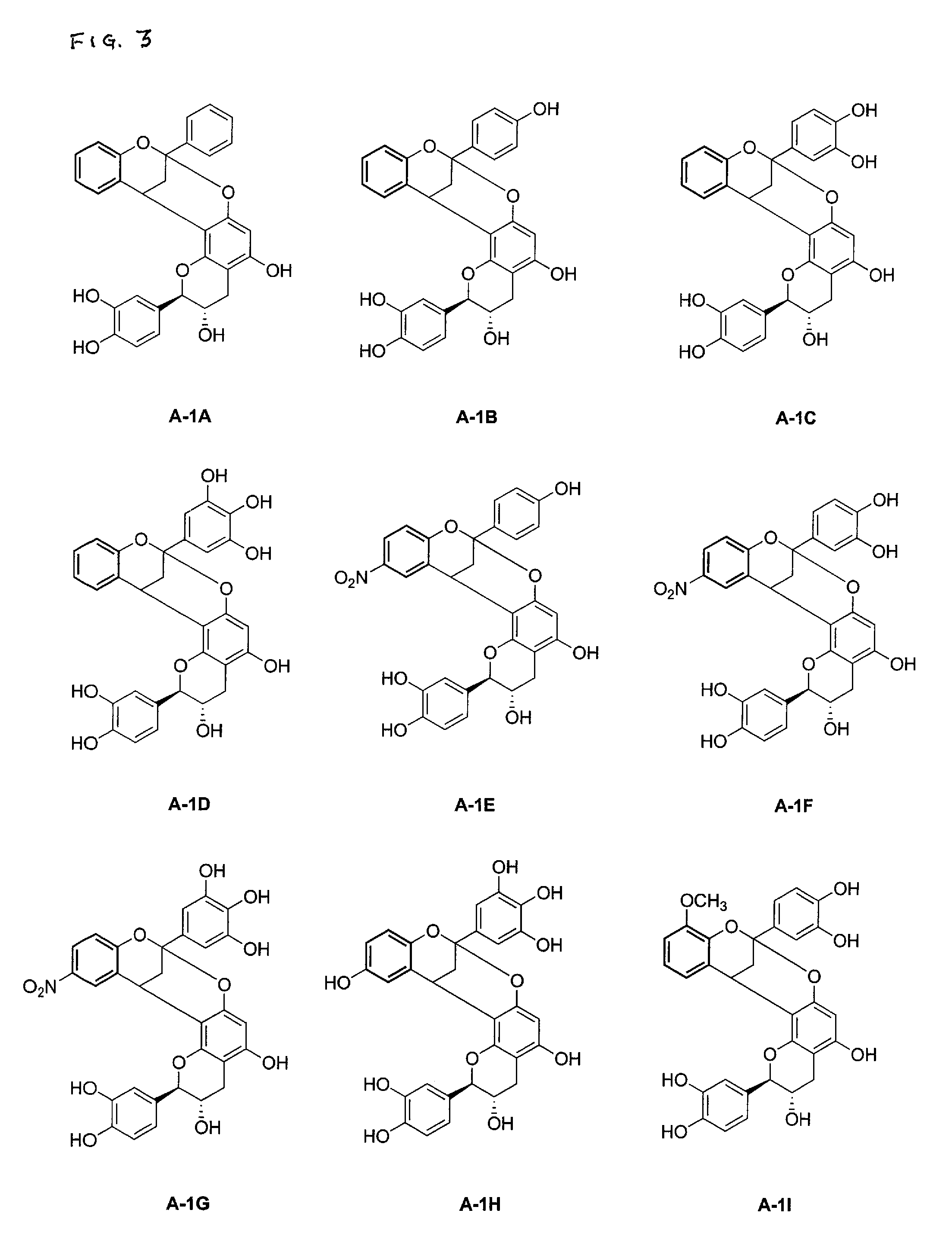Synthesis of polycyclic procyanidins
a technology of procyanidins and polycyclic compounds, applied in the field of synthesis of polycyclic procyanidins, can solve the problems of difficult synthesizing of compounds of formula i, inability to treat diabetes, and treatment needs to be evaluated, so as to improve insulin receptor function, enhance effect, and increase insulin sensitivity
- Summary
- Abstract
- Description
- Claims
- Application Information
AI Technical Summary
Benefits of technology
Problems solved by technology
Method used
Image
Examples
example 1
[0054] Table 1 depicts the reaction of catechin hydrate (C-1) with various flavylium salts (B-1) to yield compounds of Formula A-1.
TABLE 1YieldFlavanGX1Y1Z1(%)A-1(+)-catechinHHHH82A-1A(+)-catechinHHOHH79A-1B(+)-catechinHHOHOH89A-1C(+)-catechinHOHOHOH80A-1D(+)-catechin6-NO2HOHH83A-1E(+)-catechin6-NO2HOHOH76A-1F(+)-catechin6-NO2OHOHOH81A-1G(+)-catechin6-OHOHOHOH47A-1H(+)-catechin8-OCH3HOHOH70A-1I(+)-catechinHHOCH3OCH383A-1J(+)-catechin7-OCH3OCH3OCH3OCH333A-1K(−)-epicatechin6-NO2OHOHOH81A-1L(−)-6-NO2HOHOH86A-1MEpigallocatechingallate(−)-6-NO2OHOHOH71A-1NEpigallocatechingallate
example 2
[0055] Table 2 depicts the reaction of three 3-substituted flavins to yield compounds of Formula A-2.
TABLE 2W1W2Yield (%)A-2CH3CH375A-2AC2H5C2H579A-2BCH2COOHCH2COOCH383A-2C
example 3
[0056] Table 3 depicts the reaction of various flavylium perchloride salts with various phenols to yield compounds of Formula D-1. Generally, in all cases, the reactions proceeded to provide high (≧70%) yields of A-1, A-2 or D-1 under ambient temperatures and pressures.
TABLE 3R1GX1Y1Z1Yield (%)D-1OHHHOHOH76D-1AOH6-NO2HOHOH80D-1BOH6-NO2OHOHOH82D-1CH6-NO2HOHOH71D-1DOHHOHOHOH73D-1E
A. General Procedure:
[0057] To a solution of catechin or other nucleophile in methanol (0.02-0.2 M) was added flavylium salt (1.0 to 1.2 equivalent) at room temperature. The mixture was stirred at room temperature to 50° C. for 1-24 hours (monitored by TLC and NMR). After the reaction finished, the mixture was concentrated and absorbed on a small amount of silica gel. The pure product was isolated by purification of the crude mixture using flash column chromatography on silica gel with a mixture of hexane, ethyl acetate and methanol as eluent.
B. A Typical Procedure for the Synthesis of Compound A-1A:
[0...
PUM
| Property | Measurement | Unit |
|---|---|---|
| temperature | aaaaa | aaaaa |
| chromatography | aaaaa | aaaaa |
| concentrations | aaaaa | aaaaa |
Abstract
Description
Claims
Application Information
 Login to View More
Login to View More - R&D
- Intellectual Property
- Life Sciences
- Materials
- Tech Scout
- Unparalleled Data Quality
- Higher Quality Content
- 60% Fewer Hallucinations
Browse by: Latest US Patents, China's latest patents, Technical Efficacy Thesaurus, Application Domain, Technology Topic, Popular Technical Reports.
© 2025 PatSnap. All rights reserved.Legal|Privacy policy|Modern Slavery Act Transparency Statement|Sitemap|About US| Contact US: help@patsnap.com



